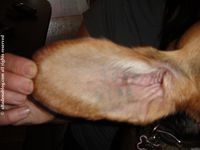Mille the beagle came to her forever home last Father's Day after a life spent as a research animal. What happens to those animals after they've given their all?
by Laura Monteros

Gus, age 8 and Millie, age 3½, are beagles who were rescued by Altadenan Sharon Ding. Gus was rescued from a shelter and wears a collar; Millie has the added distinction of sporting a bright pink bandana stamped with “Ask me where I came from.” She is a walking ambassador for the Beagle Freedom Project based in Valley Village.
Millie came from a research lab in San Jose, where she and eight other beagles had spent their entire lives in cages. They were rescued by the Beagle Freedom Project, and Ding adopted Millie on Father’s Day, 2011.
“I’m stuck on beagles,” Sharon says, but when Gus’ companion Penny died, she had not intended to get another dog—until she saw a news report on nine rescued beagles needing special homes. “I thought it was time,” she states.
Beagle Freedom
When Millie came home, she was timid and frightened, but she loved people from the very start. During most of our conversation, she sat on Sharon’s lap, and enjoyed being stroked and talked to. “She pretty much lets me do anything,” Sharon says, such as cutting her nails which Gus does not like to have done. “It’s part of her upbringing,” as is her tendency to lift her paw when Sharon walks toward her. “So many do,” she says, “I think it’s because they gave blood all the time.”
Beagle Freedom Project, a service of Animal Rescue, Media & Education (ARME), was founded by Shannon Keith in December, 2010 when Keith learned that two beagles from a research lab were being given a chance at freedom. Because of their friendly, docile, and forgiving natures, beagles are the most popular breed for lab use, according to BFP. They are purchased from breeders who specifically breed dogs for use in scientific institutions.
Though BFP does not divulge the name of the laboratory nor what was done to the dogs, Sharon says, “I understand that about half die from the experiments. Some are killed when they are done with them.” Their ears are tattooed by the lab to identify them, the only moniker they have while they live there. Some have tattoos on both ears, indicating they have lived in at least two different labs.
Urgent rescues
Since that first rescue, BFP has worked with several laboratories in five additional rescues to release dogs to them that are no longer wanted for research. The biggest by far was transporting 40 beagles from a lab in Spain on Nov. 23 of last year. This required arranging for air transport, obtaining paperwork, and clearing customs in Los Angeles. The $50,000 cost was underwritten by a note on Keith’s home. All of the dogs had bad teeth and many had tumors in their mouths. One male was eight years old.
The urgency of these rescue missions cannot be overstated. In Millie’s case, BFP had only 48 hours notice. The Spanish rescue began with an internet posting by a humane organization on Halloween, giving BFP only three weeks to complete the transaction before the dogs would be destroyed.
Before an animal is placed by Beagle Freedom Project, the organization does a phone interview and home visit with the applicant. All dogs are neutered, fully vaccinated, and micro-chipped. BFP prefers homes that already have a dog, because the rescues need a role model on how to be a real dog.
When the BFP representative visited Sharon, they were surrounded by portraits of beagles on the wall. They asked her what kind of a dog she wanted—male or female, aggressive or passive. She responded, “One that needs a little extra help.” She was given Millie.
Acting like a dog
Though Millie is fortunate in that she has good teeth and did not have the paw problems, muscle weakness, and lesions often associated with lab dogs, there have been challenges in “dogifying” an animal who has never interacted in a normal way with humans and other animals. She had never walked on a leash nor been house-trained, and she has behaviors that are unusual.
Millie sometimes blanks out and just stares. “Sometimes it takes a half hour for her to walk around the block,” because she stops so often, Sharon says. She randomly zones out on walks, and Sharon has been unable to determine a trigger.
“The hardest was housebreaking, getting her to go out. She has a routine where she runs in circles, and then goes.”
Most of Millie’s difficulties are emotional, but there were some physical signs when she was first brought home. Her vocal cords had been cut to mitigate noise in the lab. “When I first heard her, I was floored,” Sharon says of the raspy sound the girl makes when she tries for the typical beagle bay that Gus voices.
Physical evidence of lab life
Physically, Millie was a little overweight, possibly due to pregnancy. “I found out all the girls probably had litters,” Ding said. She also had enlarged nipples, possibly due to hormone testing, Sharon said. The rescued males from Millie’s lab also had enlarged genitalia.
Diet was a challenge for Millie, who had trouble digesting food. Sharon put her on an organic diet while Millie got used to the food and new home, but now she eats the same lite chow as Gus.
Watching the two dogs interact on the back deck—Sharon says they play and even sleep together sometimes—it’s hard to imagine how different Millie’s life was just a year ago. “She’s very well-adjusted now,” Sharon says. “She’s improved in the year. There’s definite improvement.” Toileting is still a problem, but as Sharon states, “Whenever she’s been a challenge, I just think about what she’s been through and I can’t get mad at her.”
LINKS
http://beaglefreedomproject.org/
Video of Millie’s rescue. She’s named “Frida” in the video.
http://beaglefreedomproject.org/bfp-second-rescue






